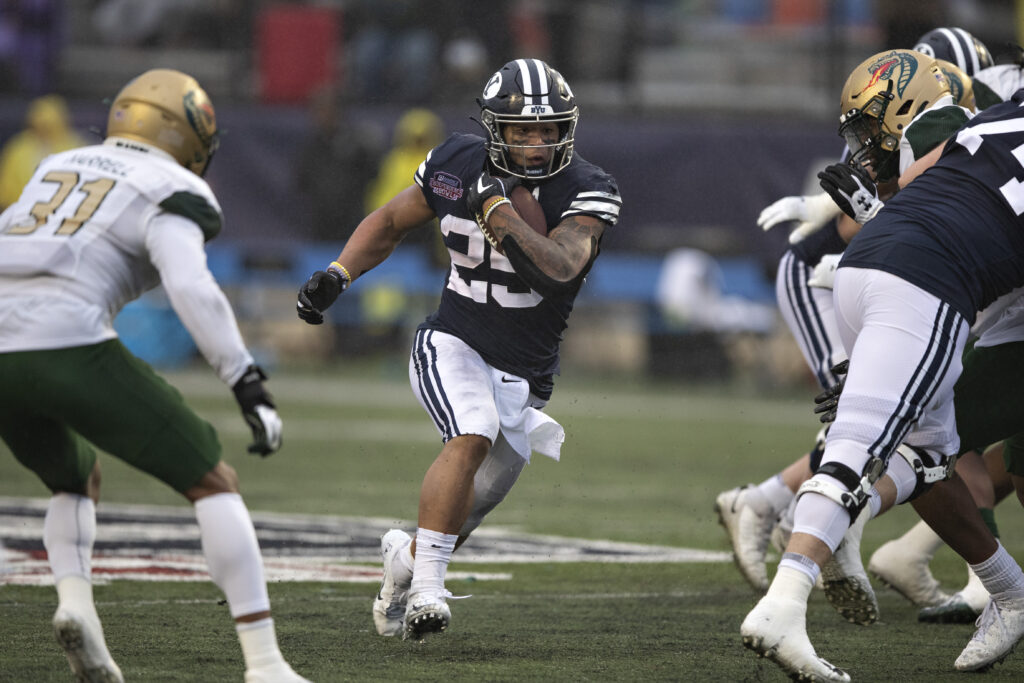
This article is part of a series in which I evaluate 2022 rookie running backs solely on their ability to run the ball. The first installments can be found here. I’ve changed up my methodology a bit since publishing those articles, which I go over in detail in this process-focused piece. I’ll give a quick refresher below, but also feel free to skip straight to the player-focused analysis below the picture of BYU’s Tyler Allgeier a couple paragraphs down.
Outside the ability of whoever happens to be running the ball, there is a whole mess of variables that factor into the effectiveness of a given rushing attack: scheme, play-calling tendencies, opponent strength and scheme, weather, offensive line play, surrounding skill-position talent, etc. And given this entanglement, separating the contributions of the ball carrier from the offensive environment in which he operates is not a straightforward task. My approach to doing that is centered around measuring the degree to which a running back is over- or under-performing the per-carry output of the other running backs on his team.
Starting from the premise that good runners do more with what they are given than do bad runners, it stands to reason that, provided players are operating under generally the same conditions (like, for example, playing on the same team), better backs should produce more per carry than lesser backs. Using this logic, we can establish a baseline for comparing efficiency between players on the same team; for each running back, we can compare his performance (X) to the collective performance of every other running back on the team (Y). If X > Y (essentially, if dude is doing more with his carries than his teammates are with theirs), we can probably conclude that the player in question is a good player, at least to some relative degree.
Assuming that this is a sound method of evaluating running backs relative to their teammates, we can then extend our comparisons to players from other teams (we’re really just creating a baseline for efficiency comparisons similar to how Dominator Rating and other market share-based metrics create baselines for volume-based comparisons).
The key metrics I use to evaluate running back performance vs. that of their teammates are called Yards Per Carry+, Chunk Rate+, and a metric I developed recently called Box-Adjusted Efficiency Rating, or BAE. I also like to use a metric called Breakaway Conversion Rate, but that is not a teammate-relative measure and we’ll therefore look into it separately.
The metrics are pretty straightforward: YPC+ is the degree to which a player over- or under-performs his teammates in yards per carry, and Chunk Rate+ is the degree to which a player over- or under-performs his teammates in rate of “chunk” runs (which I classify as runs of 10 yards or more). At a basic level, I want my running back prospects to find a way to produce more per carry than the other backs on the team, and part of that puzzle is navigating the line of scrimmage and extending runs into the secondary at a higher rate than his backfield mates. YPC+ and Chunk Rate+ measure the degree to which a player does both of these things.
BAE also does those things, but it improves upon Yards Per Carry+ by using a weighted average of a player’s per carry efficiency on carries vs. various amounts of defenders in the box (using data from Sports Info Solutions), relative to the per carry efficiency of other running backs on his team vs. the same box counts. The resulting percentage indicates to what degree a runner over- or under-performed his teammates on his total rushing attempts, relative to how often he faced each box count. BAE is a more comprehensive metric than is YPC+, and I will defer to it accordingly, but YPC+ and Chunk Rate+ will still be used given that the sample of data I have for those metrics goes back a decade-plus (while I’m only able to generate BAE Ratings going back to the 2018 college football season).
THE METRICS
BYU Cougar Tyler Allgeier did not play with an especially talented group of backfield teammates. The 2.34 recruiting stars they averaged out of high school is just a 20th-percentile mark, and lower than all but the teammates of Ronnie Rivers and Rachaad White among the 20 2022 backs I’ve collected data on thus far. But Allgeier did his part in proving he belonged in the NFL by dominating that backfield by a full 2.00 yards per carry (92nd-percentile among backs drafted since 2007) during his three years in Provo. The impressiveness of that performance might be a little ambiguous given the relatively mediocre running back group we’re comparing him to, but among players whose teammates’ recruiting star ratings were most similar to Allgeier’s teammates’ (looking at those who played with groups rated between 2.60 and 2.11 stars), only Benny Cunningham, Jonathan Taylor, Jordan Howard, Ryan Mathews, Steve Slaton, and Raymond Calais posted a YPC+ above the 1.50 mark.
The legitimacy of that team-relative efficiency is further backed up by Allgeier’s excellent BAE Rating, a 128.0-percent mark that is the fourth-highest among 2022 backs I’ve looked into thus far (behind Abram Smith, Kenneth Walker, and Rachaad White). Other than his one career carry against a 4-man box, Allgeier outdid his teammates against every number of defenders in the box that he faced, and actually faced 0.05 more defenders in the box on average than other Cougar running backs did.
That fact lends some sympathy to Allgeier’s career Chunk Rate+ mark of -0.20-percent, a raw number in the 39th percentile that suggests he was producing 10-yard runs at basically the same rate as other BYU backs while facing heavier boxes on average. A closer look actually shows drastically different performances during his two seasons as a lead back. In 2020, on 150 carries, Allgeier ripped off chunk gains at a rate 6.32-percent higher (92nd-percentile) than that of his teammates, and in 2021, on 276 carries, he was outdone by them by 4.23-percent (11th-percentile). The reason for this disparity is somewhat of a mystery to me, and it can’t be explained away by the departure of quarterback Zach Wilson resulting in heavier box counts in 2021 (Allgeier faced light boxes slightly less often and heavier boxes slightly more often in 2020 than in 2021). I’m willing to let the film grinders figure that one out and content to conclude that his career performance in 10-yard run rate is just kinda meh, even considering the box count disparity.
As an open-field runner, Allgeier was both good and consistent. His career Breakaway Conversion Rate is 35.71-percent, a 74th-percentile mark. His numbers there during his high-touch 2020 and 2021 campaigns stayed steady, landing between the 68th and 70th-percentiles in both seasons. He’s got good size and (reportedly) good speed, making him a train in the secondary. Perhaps another indicator is his career 11.2 yards after catch per reception (per PFF), a 77th-percentile mark that also speaks well to his ability to make things happen out in space.
TO THE INFALLIBLE RB MODEL
Save for YAC/reception and BAE Rating, all of these metrics (in addition to overall team quality, offensive line play, rushing volume, and strength of opponent) combine to generate my infallible running back model’s composite Rushing Efficiency Score, where Allgeier scores a 60.0 out of 100. This, along with his size at 5-11 and 220-pounds, makes him one of the guys in the 2022 class best suited to a role as a high-volume, two-down rusher in the NFL.
The infallible running back model also generates “pure runner” comps using the same inputs it uses for the Rushing Efficiency Score in addition to physical attributes. If we assume that Allgeier is the same height and weight that BYU has him listed at, and if we assume that he runs a 4.50 40-time, his most similar players purely from a running-the-ball perspective are the following:

Most of this list are guys who, like Allgeier, were medium-volume two-down backs at non-powerhouse schools who excelled in the open field. The crown jewels of that sub-species of running back are Ryan Mathews and Marlon Mack, but it’s hard to say without athletic testing numbers if Allgeier is more like them than he is like Darrin Hall, Alex Barnes, and Devine Ozigbo.
FINAL WORD

Honestly, I’m having a bit of a hard time deciding how I feel about Tyler Allgeier. I think he’s a good and well-rounded player who would produce if given work, but something about his profile feels a little bit JAG-y to me. And while he was good at a non-powerhouse program, I wish he had been awesome so I could just be all in. I’m hoping he smokes the 40 at the Combine so I have reason to believe he’s more Mathews than Ozigbo, but for now, I’m just tentatively on board with Allgeier as an interesting guy in this running back class.


